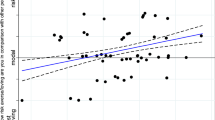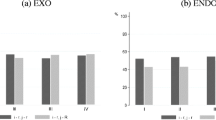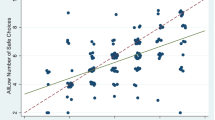Abstract
We explore situations in which a decision maker bears responsibility for somebody else’s outcomes as well as for her own. We study such choices for gains and losses, and for different gain probabilities. For 50–50 lotteries over gains we find that being responsible for somebody else’s payoffs increases risk aversion. In the loss domain, on the other hand, we find significantly different behavior relative to gains, with slightly more risk seeking under responsibility. In a second experiment, we replicate the finding of increased risk aversion for large probabilities of a gain, while for small probability gains we find increased risk seeking under conditions of responsibility relative to large probabilities. This discredits hypotheses of a ‘cautious shift’ under responsibility, and may indicate an accentuation of the fourfold pattern of risk attitudes usually found for individual choices.





Similar content being viewed by others
Notes
Pahlke, Strasser, and Vieider (2012) found that adding an accountability mechanism to responsibility significantly reduced loss aversion, while leaving other elements of risk attitude unaffected.
Additional prospects in the gain domain were not mirrored for ethical reasons—indeed, replicating all gain prospects for losses would have resulted in a high chance of overall losses during the experiment.
Two out of 144 participants ended up with an actual loss (€ -3.50 and € -2.00), both in the individual treatment. Three further subjects earned less than their show-up fee of €4.
P-values reported are two-sided and refer to binomial tests for intermediate stakes, with a safe amount of b = €6, unless specified otherwise. Using one specific stake level allows for cleaner statistical tests. Results are qualitatively similar for other stake levels.
Slovic et al. (2002) found a similar pattern for choices under risk with small negative and large positive outcomes, calling it the “contrast effect”.
The Spearman correlation coefficient between the stake size b and choice for the safe option in the individual treatment is indeed significantly positive for the base case (p < 0.001), but not different from zero for losses (p = 0.57).
Expected value is defined as the expected value of the safe prospect minus the expected value of the risky prospect. Standard deviation is defined as the standard deviation of the risky prospect minus the standard deviation of the safe prospect, which is thus always positive.
One may also want to take into account that there are actually fewer choices of the safe prospect for losses to start with, as shown above.
The average rating was 4.04, with a standard deviation of 1.06.
In the literature, self assessment on a risk attitude scale such as this have been found to be highly correlated with incentivized choices for 50–50 prospects in the gain domain (Dohmen et al. 2011). We thus also assume that such self-assessment should reflect choices for 50–50 choices in the gain domain. However, Vieider et al. (2014) found positive correlations in both the gain and the loss domain.
For instance, Lahno and Serra-Garcia (2015) found that the imitation of a peer is more likely in decisions under risk when said peer makes a risk averse choice. This suggests that risk aversion may have some appeal as a social norm.
We test this hypothesis for the gain domain only, since gains are easier to incentivize than losses.
Although the preceding experiment was unrelated, care was taken to distribute the treatments of this experiment orthogonally to the treatments in the other experiment.
Indeed, the dummy indicates the satisfaction levels for small probabilities with all interactions that include that dummy held constant at zero (Jaccard and Turrisi 2003). This in turn means that the safe-choice dummy must be zero, thus resulting in the interpretation that the effect indicates satisfaction with choices of the prospect; this satisfaction in turn is measured relative to the (much fewer) choices of the prospect for the large probability prospect.
References
Abdellaoui, M. (2000). Parameter-free elicitation of utility and probability weighting functions. Management Science, 46(1), 1497–1512.
Abdellaoui, M., L’Haridon, O., & Zank, H. (2010). Separating curvature and elevation: A parametric probability weighting function. Journal of Risk and Uncertainty, 41(1), 39–65.
Abdellaoui, M., Baillon, A., Placido, L., & Wakker, P. P. (2011). The rich domain of uncertainty: Source functions and their experimental implementation. American Economic Review, 101, 695–723.
Andersson, O., Holm, H. J., Tyran, J.-R. & Wengström, E. (2015). Deciding for others reduces loss aversion. Management Science, forthcoming.
Bateman, I., & Munro, A. (2008). An experiment on risky choice amongst households. Economic Journal, 115, C176–C189.
Baucells, M., Weber, M., & Welfens, F. (2011). Reference point formation and updating. Management Science, 57(3), 506–519.
Binswanger, H. P. (1980). Attitudes toward risk: Experimental measurement in rural India. American Journal of Agricultural Economics, 62(3), 395–407.
Bleichrodt, H., & Pinto, J. L. (2000). A parameter-free elicitation of the probability weighting function in medical decision analysis. Management Science, 46(11), 1485–1496.
Bolton, G. E., & Ockenfels, A. (2010). Risk taking and social comparison—A comment on “Betrayal aversion: evidence from Brazil, China, Oman, Switzerland, Turkey, and the United States.” American Economic Review, 100(1), 628–633.
Chakravarty, S., Harrison, G. W., Haruvy, E. E., & Rutström, E. E. (2011). Are you risk averse over other people’s money? Southern Economic Journal, 77(4), 901–913.
Charness, G., & Jackson, M. O. (2009). The role of responsibility in strategic risk taking. Journal of Economic Behavior and Organization, 69, 241–247.
Dohmen, T., Falk, A., Heckman, J., Huffman, D., Sunde, U., Schupp, J., & Wagner, G. G. (2011). Individual risk attitudes: Measurement, determinants, and behavioral consequences. Journal of the European Economic Association, 9(3), 522–550.
Donkers, B., Melenberg, B., & van Soest, A. (2001). Estimating risk attitudes using lotteries: A large sample approach. Journal of Risk and Uncertainty, 22(2), 165–195.
Eckel, C. C., & Grossman, P. J. (2008). Men, women, and risk aversion: Experimental evidence. Handbook of Experimental Economics Results, 1, 1061–1073.
Fehr-Duda, H., Bruhin, A., Epper, T. F., & Schubert, R. (2010). Rationality on the rise: Why relative risk aversion increases with stake size. Journal of Risk and Uncertainty, 40(2), 147–180.
Fiegenbaum, A. (1990). Prospect theory and the risk-return association. Journal of Economic Behavior and Organization, 14, 187–203.
Fiegenbaum, A., & Thomas, H. (1988). Attitudes toward risk and the risk-return paradox: Prospect theory explanations. Academy of Management Journal, 31(1), 85–106.
Fischbacher, U. (2007). z-Tree: Zurich toolbox for ready-made economic experiments. Experimental Economics, 10(2), 171–178.
Greenwald, A. G. (1978). Within-subject designs: To use or not to use? Psychological Bulletin, 314–320.
Greiner, B. (2004). The online recruitment system ORSEE 2.0 – A guide for the organization of experiments in economics. University of Cologne, Working Paper Series in Economics 10.
Holt, C. A., & Laury, S. K. (2002). Risk aversion and incentive effects. American Economic Review, 1644–1655.
Hsee, C. K., & Weber, E. U. (1997). A fundamental prediction error: Self–others discrepancies in risk preference. Journal of Experimental Psychology: General, 146(1), 45–52.
Humphrey, S. J., & Renner, E. (2011). The social cost of responsibility. Working Paper.
Jaccard, J., & Turrisi, R. (2003). Interaction effects in multiple regression (2nd ed.). London: Sage Publications.
Kachelmeier, S. J., & Shehata, M. (1992). Examining risk preferences under high monetary incentives: Experimental evidence from the People’s Republic of China. American Economic Review, 82(5), 1120–1141.
Kahneman, D., & Tversky, A. (1979). Prospect theory: An analysis of decision under risk. Econometrica, 47(2), 263–291.
Lahno, A. M., & Serra-Garcia, M. (2015). Peer effects in risk taking: Envy or conformity? Journal of Risk and Uncertainty, 50, 73–95.
Lefebvre, M., Vieider, F. M., & Villeval, M. C. (2010). Incentive effects on risk attitude in small probability prospects. Economics Letters, 109, 115–120.
Maafi, H. (2011). Preference reversals under ambiguity. Management Science, 57(11), 2054–2066.
Pahlke, J., Strasser, S., & Vieider, F. M. (2012). Risk taking for others under accountability. Economics Letters, 114(1), 102–105.
Reynolds, D. B., Joseph, J., & Sherwood, R. (2009). Risky shift versus cautious shift: Determining differences in risk taking between private and public management decision making. Journal of Business and Economics Research, 7(1), 63–77.
Rohde, I. M. T., & Rohde, K. I. M. (2011). Risk attitudes in a social context. Journal of Risk and Uncertainty, 43, 205–225.
Scholten, M., & Read, D. (2014). Prospect theory and the “forgotten” fourfold pattern of risk preferences. Journal of Risk and Uncertainty, 48, 67–83.
Slovic, P., Finucane, M. L., Peters, E., & MacGregor, D. G. (2002). The affect heuristic. In T. Gilovich, D. Griffin, & D. Kahneman (Eds.), Heuristic and biases: The psychology of intuitive judgment (pp. 397–420). New York: Cambridge University Press.
Starmer, C. (1999). Experimental economics: Hard science or wasteful tinkering? Economic Journal, 109(453), 5–15.
Starmer, C. (2000). Developments in non-expected utility theory: The hunt for a descriptive theory of choice under risk. Journal of Economic Literature, 38, 332–382.
Tversky, A., & Kahneman, D. (1992). Advances in prospect theory: Cumulative representation of uncertainty. Journal of Risk and Uncertainty, 5, 297–323.
Vieider, F. M., Lefebvre, M., Bouchouicha, R., Chmura, T., Hakimov, R., Krawczyk, M., & Martinsson, P. (2015a). Common components of risk and uncertainty attitudes across contexts and domains: Evidence from 30 countries. Journal of the European Economic Association, 13(3), 421–452.
Vieider, F. M., Villegas-Palacio, C., Martinsson, P., & Mejia, M. (2015b). Risk taking for oneself and others: A structural model approach. Economic Inquiry, forthcoming.
Viscusi, W. K., & Huber, J. (2012). Reference-dependent valuations of risk: Why willingness-to-accept exceeds willingess-to-pay. Journal of Risk and Uncertainty, 44(1), 19–44.
Wakker, P. P. (2010). Prospect theory for risk and uncertainty. Cambridge: Cambridge University Press.
Wiseman, R. M., & Gomez-Mejia, L. R. (1998). A behavioral agency model of managerial risk taking. Academy of Management Review, 23(1), 133–153.
Author information
Authors and Affiliations
Corresponding author
Electronic supplementary material
Below is the link to the electronic supplementary material.
ESM 1
(DOCX 165 kb)
Rights and permissions
About this article
Cite this article
Pahlke, J., Strasser, S. & Vieider, F.M. Responsibility effects in decision making under risk. J Risk Uncertain 51, 125–146 (2015). https://doi.org/10.1007/s11166-015-9223-6
Published:
Issue Date:
DOI: https://doi.org/10.1007/s11166-015-9223-6




